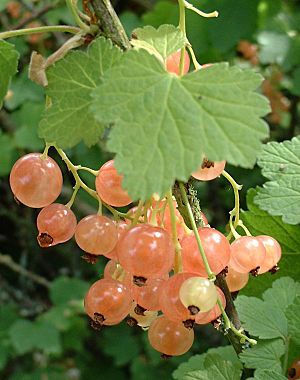White currant facts for kids
Quick facts for kids White currant |
|
|---|---|
 |
|
| Hybrid parentage | Ribes rubrum (red currant) |
| Origin | Central and Eastern Europe |
The white currant is a special type of plant, like a unique version of the red currant. It's a flowering plant that grows naturally in Europe. These plants usually grow as a shrub, which is a bushy plant, and can get about 1 meter (3 feet) tall.
White currant plants have leaves that look a bit like a hand with fingers spread out. In summer, they grow lots of small, round, and tasty fruits called berries. The main difference between white currants and red currants is the color and taste of their berries. White currants have berries that are clear white and taste sweeter than red ones.
Sometimes, white currants are mistakenly called Ribes glandulosum, which is a different plant found in the USA.
| Nutritional value per 100 g (3.5 oz) | |
|---|---|
| Energy | 234 kJ (56 kcal) |
|
13.8 g
|
|
| Sugars | 7.37 g |
| Dietary fiber | 4.3 g |
|
0.2 g
|
|
|
Protein
|
1.4 g
|
| Vitamins | Quantity
%DV†
|
| Thiamine (B1) |
3%
0.04 mg |
| Riboflavin (B2) |
4%
0.05 mg |
| Niacin (B3) |
1%
0.1 mg |
| Pantothenic acid (B5) |
1%
0.064 mg |
| Vitamin B6 |
5%
0.07 mg |
| Folate (B9) |
2%
8 μg |
| Choline |
2%
7.6 mg |
| Vitamin C |
49%
41 mg |
| Vitamin E |
1%
0.1 mg |
| Vitamin K |
10%
11 μg |
| Minerals | Quantity
%DV†
|
| Calcium |
3%
33 mg |
| Iron |
8%
1 mg |
| Magnesium |
4%
13 mg |
| Manganese |
9%
0.186 mg |
| Phosphorus |
6%
44 mg |
| Potassium |
9%
275 mg |
| Sodium |
0%
1 mg |
| Zinc |
2%
0.23 mg |
|
Link to USDA Database entry
|
|
| †Percentages estimated using US recommendations for adults. | |
Contents
Growing White Currant Plants
White currant plants are grown for their beautiful look and their delicious berries. They are a bit like their cousin, the blackcurrant, but they are also used to make gardens look pretty.
Where to Plant White Currants
Currant bushes like places that get some sun or full sun. You can plant them between November and March. They grow best in soil that drains water well and is a little bit neutral to acidic.
These plants are quite easy to take care of. They prefer cooler weather, so they grow and produce more fruit in northern areas. You can even grow them in big pots if you don't have a garden.
Harvesting and Storing Berries
The berries are firm and juicy, and they are usually ready to pick in the summer. When you harvest them, it's best to cut off whole bunches of fruit, not just individual berries.
After picking, you can use the berries right away. Or, you can store them in a fridge to keep them fresh for a while. They can also be put into bags and frozen to enjoy later!
Different Types of White Currants
There are several different types, or "cultivars," of white currants. Some popular ones include 'White Grape', 'Blanka', and 'Versailles Blanche'. Another type is called 'White Pearl'.
The 'White Grape' type is very special. It has won an award called the Royal Horticultural Society's Award of Garden Merit. This award means it's a great plant for gardens.
Did you know there are also currant plants that grow yellow and pink berries? They are called yellow currants and pink currants!
Common Plant Problems
Sometimes, white currant bushes can have problems with small insects like the gooseberry sawfly. Birds also love to eat the berries, so gardeners sometimes need to protect their plants from them.
Cooking with White Currants
White currant berries are usually a bit smaller and sweeter than red currants. When people make jams and jellies from white currants, the result is often a lovely pink color.
Even though it's called a "white" currant, it's actually a special white version of the red currant. It's like an albino red currant, but it's sold as its own unique fruit.
How People Use White Currants
White currants are not often used in savory dishes (foods that are not sweet). They are usually eaten fresh and raw because they have a sweet but slightly tart taste.
People also make many sweet things from white currants. These include preserves, jellies, wines, and syrups. A very famous jelly called Bar-le-duc or Lorraine jelly traditionally uses white currants. However, you can also find this jelly made with red currants.
Healthy Benefits of White Currants
These little berries are good for you! They are a great source of Vitamin C and Vitamin K. They also have lots of iron, copper, and manganese, which are important minerals your body needs.
Related Berries and Plants

